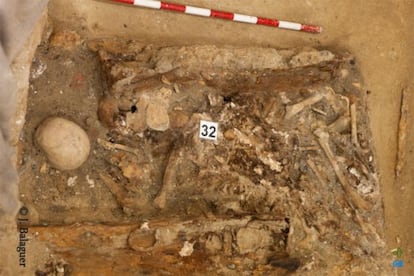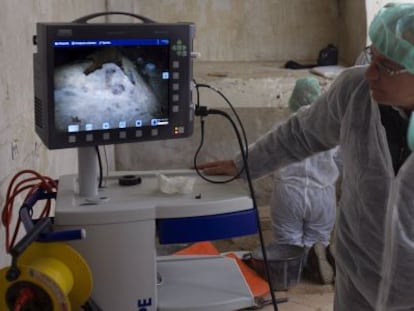Questions and answers about the remains of Miguel de Cervantes
A lack of definitive proof over the identification has left a number of issues unclear The team has ruled out DNA testing on the bones they believe to belong to the literary great

Despite news reports to the contrary on Tuesday, there is no 100-percent guarantee that the remains discovered in a Madrid church belong to Miguel de Cervantes Saavedra, the poet, novelist and author of Don Quixote. That’s according to Francisco Etxeberria, a forensic scientist and director of a team of 36 experts that has been working to identify bones discovered inside a former convent in the Spanish capital, and who presented their conclusions to the world yesterday.
There is, they reported, no DNA evidence to support the identification of several bones as belonging to Cervantes. But, Etxeberria explained, “it is possible” that “some fragments” of the remains belong to the celebrated writer, “on the basis of all of the information generated in the historical, archaeological and anthropological sense.”
The supposed remains of Cervantes (1547-1616) were discovered mixed with those of another 16 people, including his wife, in a crypt under the former Convent of the Barefoot Trinitarians, located in the Las Letras neighborhood. The bones, which belonged to six men, five women and six children, were located 1.35 meters underground and had lain there since 1730, a century after the death of the writer.
The remains had been moved there between 1673 and 1698, due to the construction of a new church within the convent itself. The remains that are most likely attributable to Cervantes were from four adults – specifically a jaw bone that shows evidence of damage before death, as was noted in writings by Cervantes himself days before he passed away.
“We have not been able to resolve this with complete certainty, which is why we are being prudent,” Etxeberria told reporters on Tuesday. “We are convinced that we have something.”

The announcement was made at Madrid City Hall, in the presence of outgoing mayor Ana Botella, who has been an enthusiastic supporter of the project.
But the announcement left as many questions unanswered as it did answered. What follows is a summary of what is known about the discovery and what remains shrouded in mystery.
Why did Cervantes want to be buried in the Trinitarian convent?
He was a local resident, living in nearby León street. Don Quixote was dedicated to the Count of Lemos, protector of the nuns living there. And his illegitimate daughter, Isabel de Saavedra, was also there, as well as her mother, both of whom were nuns.

How was it known that they were there?
In 1869, the Royal Academy of Language ordered an investigation. In March 1870, the head of the project announced that it was highly likely that the remains were there. The complete history of the investigation was documented in a work entitled The Burial of Miguel de Cervantes.
Who are the 16 people who were buried with Cervantes?
The bodies were interred there between 1612 and 1630 after transferring them from the former church and they were discovered with liturgical clothing, as well as with a coin dating from the end of the 17th century, which coincides with the time that the remains would have been moved. There are traces of a minimum of five children and a minimum of 10 adults (four men, two women, two indeterminable and two who were probably men).
Why did the project take so long to get going?
Due to the need to harmonize ecclesiastical, political and budgetary interests. This investigation was given the green light by the regional government and the Archbishopric of Madrid, who gave authorization to the City Council to begin scientific exploration work from January 2014 onward. The first phase of the studies was carried out by geo-radar expert Luis Avial. The second phase was started in January 2015, by the team led by Francisco Etxeberria.
Why has the forensic scientist Etxeberria not clearly identified the remains as belonging to Cervantes?
Basically due to a lack of material to provide a comparison, such as DNA. In spite of that, he has stated that there is no disagreement between historians, archeologists and anthropologists on his team in terms of the discovery of the bones.
Why have there been no DNA tests if the location of Cervantes’ sister is known?
His sister, Luisa de Belén Cervantes, was also a nun, and is buried in the city of Alcalá de Henares, in a convent named De la Imagen. Exteberria says that, according to the council, her remains are buried along with those of other nuns. But that cannot be proved, and there are also doubts about whether the convent was looted and destroyed during the Spanish Civil War as the nuns claim. Historian Francisco Marín Perellón, for his part, has explained that the burial of Discalced Carmelite nuns was usually carried out directly in the earth and using a simple shroud, meaning that the remains would have decomposed beyond recognition.
Could another DNA test be carried out using the remains of the daughter of Cervantes?
There is a possibility of locating the remains of Isabel de Saavedra, who was the daughter of Cervantes and the actress Ana Franco, but this idea has been rejected.
A casket was found in the crypt bearing the initials M. C. Did that belong to Cervantes?
No. That came from a much later time period. The initials may have been added so that the remains contained within would not be lost.
How much did the two phases of the investigation cost?
The first, €12,000, and the second, €102,000 that came out of municipal funds.
Will there be a third phase?
Presumably, yes. At this time, laboratory tests that could not be carried out inside the convent will be completed off site.
Why did the researchers have to accept an agreement of confidentiality?
To avoid information leaking, and so that it could be released all at once, according to Etxeberria.
Has any institution suggested that the convent be converted into a cultural center dedicated to the time of Cervantes?
There are conversations going on and a raft of different ideas about this, supported by Jaime Lissavetzky, who is the municipal spokesperson for the opposition Socialists in the City Council, and by his colleague Ana d’Atri, who is in charge of cultural matters.
Is the Archbishopric of Madrid considering this possibility?
There is a part of the convent next to the church that could be used for such purposes. That has been suggested by Jorge López Teulón, the priest who is supervising the investigation on the part of the Archbishopric.
Are there any plans for the crypt to be opened to the public?
Yes, this is one of the ideas being considered. A burial mound would be installed in the crypt and a circuit for visitors would be installed.
Has there been any political pressure on the researchers?
The delay in the release of information is due “exclusively to the need to finish examining the archives,” according to José Marín Perellón, a doctor of modern history and the person in charge of the research paperwork.
Are there plans for a state funeral for the remains of Cervantes?
“Organizing that is not the City Council’s responsibility,” explained Madrid Mayor Ana Botella in response to that question, stating that such an option would be down to state authorities.
Tu suscripción se está usando en otro dispositivo
¿Quieres añadir otro usuario a tu suscripción?
Si continúas leyendo en este dispositivo, no se podrá leer en el otro.
FlechaTu suscripción se está usando en otro dispositivo y solo puedes acceder a EL PAÍS desde un dispositivo a la vez.
Si quieres compartir tu cuenta, cambia tu suscripción a la modalidad Premium, así podrás añadir otro usuario. Cada uno accederá con su propia cuenta de email, lo que os permitirá personalizar vuestra experiencia en EL PAÍS.
¿Tienes una suscripción de empresa? Accede aquí para contratar más cuentas.
En el caso de no saber quién está usando tu cuenta, te recomendamos cambiar tu contraseña aquí.
Si decides continuar compartiendo tu cuenta, este mensaje se mostrará en tu dispositivo y en el de la otra persona que está usando tu cuenta de forma indefinida, afectando a tu experiencia de lectura. Puedes consultar aquí los términos y condiciones de la suscripción digital.
More information
Últimas noticias
Reinhard Genzel, Nobel laureate in physics: ‘One-minute videos will never give you the truth’
Pinochet’s victims grapple with José Antonio Kast’s rise in Chile
How Japan is trying to avert ‘digital defeat’
The complicated life of Francesca Albanese: A rising figure in Italy but barred from every bank by Trump’s sanctions
Most viewed
- Pablo Escobar’s hippos: A serious environmental problem, 40 years on
- Why we lost the habit of sleeping in two segments and how that changed our sense of time
- Charles Dubouloz, mountaineering star, retires at 36 with a farewell tour inspired by Walter Bonatti
- Trump’s obsession with putting his name on everything is unprecedented in the United States
- The Florida Keys tourist paradise is besieged by immigration agents: ‘We’ve never seen anything like this’









































